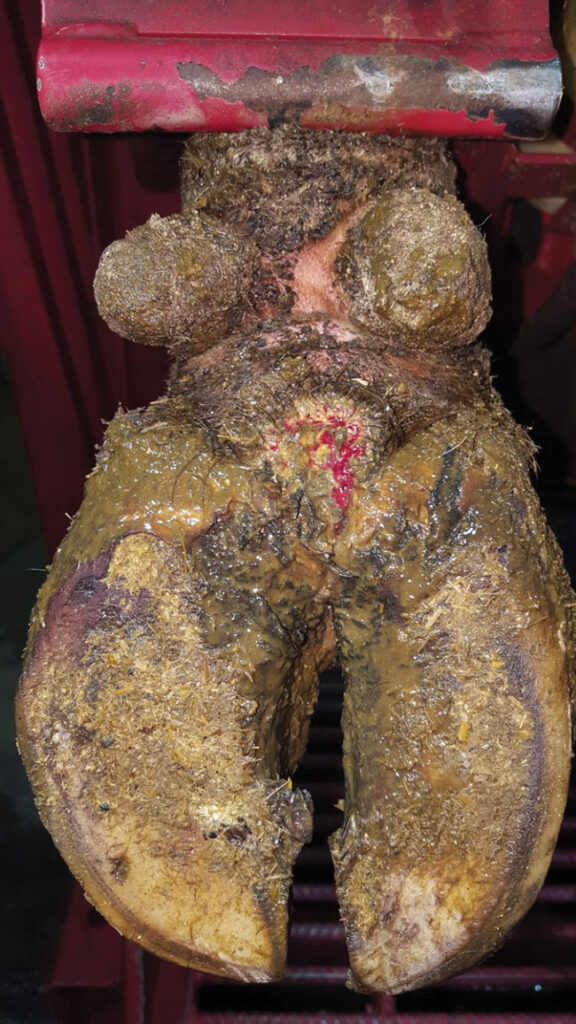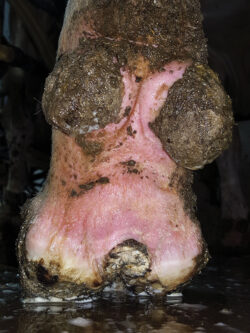
Features
Applications
Dairy
Hoofing it in manure
Cleaner barns, alternatives could reduce use of copper sulfate for digital dermatitis.
November 21, 2023 by James Careless
 Digital dermatitis, also known as hairy heel warts, is the leading cause of lameness in dairy cattle.
Photo: © Image’in / adobe stock
Digital dermatitis, also known as hairy heel warts, is the leading cause of lameness in dairy cattle.
Photo: © Image’in / adobe stock The health and well-being of cows in the dairy industry is vital to farmers.
So when a disease like digital dermatitis shows up, they need to combat it immediately. The disease, discovered in Italy in 1974, is predominantly an anaerobic bacterium that attacks the skin and tissues of the hooves of animals standing in, well, fecal matter.
Also known as hairy heel warts, digital dermatitis is the leading cause of lameness in dairy cattle.
“It is a bacteria essentially that gets into the cow’s hoof through breaks in the skin between or around the hoof,” says Aerica Bjurstrom, a regional dairy educator at the University of Wisconsin-Madison. “And once the cow has it, she has it for life. So you can’t cure it, you can only manage it.”
It is customary for dairy farms to treat this disease with copper sulfate foot baths, which the cows walk through on their way to be milked.
“It’s a relatively cheap product to use,” says Bjurstrom. “Copper sulfate is easy for farms to mix, relatively inexpensive and it does a good job as a disinfectant. It keeps the digital dermatitis at bay.”
For the record, the mix recommended by the UW School of Veterinary Medicine is “two to five percent copper sulfate in water in a 96 square foot foot bath.”
The problem is copper sulfate can be toxic, and it leaches into our soils and water after being used in these baths. Feed grown in these soils is thus contaminated by copper sulfate.
To assess how serious a problem this is, Bjurstrom and her colleagues at the University of Wisconsin have scored nearly 11,000 dairy cows for digital dermatitis in 45 eastern Wisconsin
dairy herds.
In her most recent research into the impact of copper sulfate footbath use on manure, soil, and forage, copper concentrations in eastern Wisconsin, soil, alfalfa plants, manure and cow livers from 20 farms in 12 Wisconsin counties were evaluated for copper concentrations.
Most recently, Bjurstrom presented the results of her research as part of the education sessions at the 2023 North American Manure Expo, which was held in Arlington, WI this past August.
An accumulating problem
According to available data, about 70 percent of U.S. dairy herds are affected by digital dermatitis. Worse yet, “95 percent of the large herds have digital dermatitis,” says Bjurstrom.
Copper sulfate foot baths are being widely used to treat the disease. And because one bath can only treat 150 to 300 cows, they are constantly being dumped out into the farm’s manure holding system and replaced. This means a herd of 1,000 cows goes through three to four foot baths several times a week.
While effective, constant reliance on copper sulfate foot baths can lead to an accumulation of copper in the soil, groundwater, manure and livestock.
“Just with this 1000 cow dairy example, you’re putting close to 4,000 pounds of copper back into the fields through the manure,” says Bjurstrom.
The result: “Over the course of time, copper has been building up in the environment very gradually, and it’s been building up over many years.” Moreover, as dairy cattle eat forage that is contaminated with copper, copper builds up in their livers and manure.
The contaminant that doesn’t disappear
When dairy cattle consume feed with copper in it, they excrete much of that copper through their manure. “It’s not so much that the manure is bad to put on the fields or a plant can’t use the copper because the plants do use the copper,” says Bjurstrom. “It’s just that they can only use so much. And once you put that copper in the field, it does not go anywhere.”

The bacteria attacks skin and tissues of the hoves of animal standing in fecal matter.
Instead, that copper gets taken up by crops planted in the field. “Those plants are bringing up that copper into the food that we feed to these cows,” says Bjurstrom. “That’s going back to the cows. And we are seeing increased levels of copper in their livers and soft tissues.”
“Michigan State [University] did a comparison of copper concentrations in adult dairy cows from 2007 to 2015,” she explains. “I collected 26 liver samples from dairy cows from one of the participating farms. And my numbers were very similar to what Michigan State had found. We didn’t have any cows that were running into the toxicity level, but we had quite a few that were close to concerning levels.”
This isn’t great news for the cattle industry. Over time “the copper accumulation causes oxidative liver damage,” says Bjurstrom. “When cattle are stressed, copper can be released from the liver into the bloodstream where it causes the destruction of red blood cells and death.”
Ways to reduce copper sulfate usage
So, we now know that a disease of the hoof can lead to an accumulation of copper sulfate in the fields. This in turn propagates into the food chain for the cows, which accumulates in their liver before potentially being released into their bloodstream to cause injury and even death.
The good news: it doesn’t have to be this way. “For instance, there are other types of foot baths available,” says Bjurstrom. “There are zinc sulfates, which ultimately if you use it as much as you use copper sulfate, you’re going to run into the same situation and have an excess of zinc in the field. There are other products such as formalin. It works really well, but it’s a carcinogen, so people don’t necessarily want to use that either.”
With so many different options, all of which have advantages and drawbacks, a better solution might be to reduce the need for foo tbaths.
Many agree that a more environmentally friendly, sustainable and safe solution is enhanced cleanliness in cattle barns.
After all, “digital dermatitis is caused or spread through cows standing in manure and having wet, dirty feet,” says Bjurstrom. “So maybe things as simple as scraping the barn alleys more often and keeping their feet drier could be a potential way to reduce the amount of copper sulfate used.”
In other words, stop making your cows stand in manure to fight the spread of digital dermatitis.
The bacteria may be widespread, but it cannot spread without the the presence of wet cattle feet trouncing around manure in the first place.
Is enhanced cleanliness practical?
Enhanced cleanliness seems like common sense. However, it might legitimately be too much to ask for many dairy operators, especially for those with large herds. Time and money will always be factors.
“I’m sure everybody would like to have a cleaner barn on a daily basis,” says Bjurstrom. “Sometimes that’s not possible. But yes, having a cleaner floor for the cows to stand on will probably help with reducing that spread any time there’s new cows coming into the barn – and checking them for digital dermatitis.
“And there are products that allow you to spot-treat this problem as needed, rather than treat entire herds daily,” says Bjurstrom.
“Of course, you can’t make this work unless you have a good foot health program: You can’t typically find digital dermatitis unless you’re actually lifting up the foot and looking at that cow’s feet. So being aware of which cows have it is a big bonus as well.”
The bottom line
The unavoidable consequence of copper sulfate and any other chemicals used in digital dermatitis foot baths accumulating in the soil, manure and cow livers means that current practices are unsustainable.
As impractical as enhanced cleanliness and foot care may seem to be as a solution to this problem – or at least a management approach – it is apparently the only sustainable approach to digital dermatitis over the long term. •